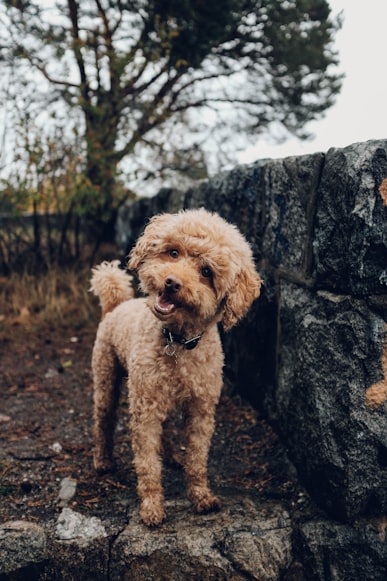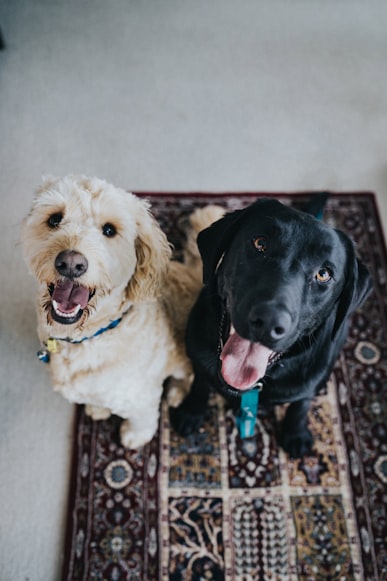1. Understanding Anxiety in Puppies

1. Understanding Anxiety in Puppies
Anxiety is a common issue among puppies, affecting up to 30% of them. It can manifest in various ways, from mild nervousness to severe fear or panic. Understanding the triggers, symptoms, and root causes of anxiety is crucial for effective training and management.
Common Triggers and Symptoms of Anxiety
Triggers for puppy anxiety can include:
- Separation from caregivers
- Loud noises (e.g., thunderstorms, fireworks)
- Unfamiliar people or animals
- Changes in routine or environment
Symptoms of anxiety in puppies may include:
- Panting, pacing, or trembling
- Destructive chewing or barking
- Hiding or escaping
- Refusing to eat or go to the bathroom
- Changes in appetite or sleep patterns
Underlying Causes of Anxiety
There are several factors that can contribute to anxiety in puppies, including:
- Genetics: Some breeds are more prone to anxiety than others.
- Early experiences: Traumatic or stressful events in a puppy’s early life can increase the risk of anxiety.
- Temperament: Puppies with shy or fearful temperaments may be more susceptible to anxiety.
- Socialization: Insufficient exposure to different people, places, and experiences can lead to anxiety in later life.
- Medical conditions: Underlying health issues, such as hypothyroidism or allergies, can also manifest as anxiety-like symptoms.
Importance of Early Intervention
It’s essential to address anxiety in puppies early on to prevent it from becoming chronic or worsening over time. By understanding the triggers and underlying causes, dog trainers can develop effective training plans to help puppies manage their anxiety and live happier, more fulfilling lives.
2. Creating a Calm Environment

As a puppy owner, it’s essential to provide a safe and comfortable environment to help them overcome anxiety and promote well-being. Here’s how to create a calming atmosphere for your anxious pup:
1. Establishing a Safe and Predictable Routine
- Establish a regular feeding and walking schedule: Predictability helps reduce uncertainty and provides a sense of security.
- Create a designated sleeping area: Provide a quiet and cozy bed in a low-traffic area where your puppy feels safe.
- Set aside specific times for play and interaction: Engage with your puppy regularly to build a strong bond and reduce boredom.
2. Providing a Quiet and Comfortable Sleeping Space
- Choose a quiet room: Select a room that’s away from noise and distractions, such as a bedroom or spare room.
- Provide a soft and comfortable bed: Use a plush dog bed with supportive padding to ensure your puppy feels at ease.
- Add a blanket or favorite toy: Familiar scents and objects can provide comfort and reduce anxiety.
3. Using Calming Scents and Music
- Use calming scents: Lavender, chamomile, and valerian are known to have calming effects. Diffuse these scents into the environment using an essential oil diffuser.
- Play soothing music: Soft, classical music or nature sounds can help mask external noises and promote relaxation.
Additional Tips for Creating a Calm Environment:
- Avoid overwhelming your puppy: Limit the number of visitors or guests while your puppy is settling in.
- Provide plenty of exercise: Exercise releases endorphins, which can help reduce anxiety levels.
- Use positive reinforcement: Reward your puppy for calm and relaxed behavior to reinforce desirable behaviors.
- Consider pheromone products: Pheromone diffusers or sprays release synthetic pheromones that mimic natural calming signals from a mother dog.
By creating a calm and secure environment, you can help your anxious puppy feel more at ease and build a stronger bond with you. With patience and consistency, you can help your furry friend overcome anxiety and live a happy and fulfilling life.
3. Building Confidence

Anxiety in puppies is a common issue that can impair their well-being and quality of life. As a dog training expert, it’s crucial to address anxiety early on by building confidence in these young pups. Here are effective strategies for instilling confidence and reducing anxiety:
1. Positive Reinforcement Training
Reward-based training methods encourage desirable behaviors in puppies. When a puppy responds calmly to a trigger that typically elicits anxiety, reward it immediately with treats, praise, or affection. This positive reinforcement associates calmness with good outcomes and reinforces desired responses.
2. Gradual Exposure
Gradually expose puppies to situations or experiences that trigger anxiety while maintaining a safe and controlled environment. Start with brief, positive exposures and gradually increase the duration and intensity. By providing a supportive presence, you can help puppies learn to cope with their fears and build confidence.
3. Controlled Socialization
Socialization is essential for puppies, but it should be done in controlled environments. Introduce puppies to new people, animals, and places in a safe and supervised manner. Encourage positive interactions and avoid overwhelming situations. Successful socialization experiences boost confidence and reduce fear of unfamiliar stimuli.
Additional Tips:
- Ensure Adequate Exercise: Physical activity releases endorphins that have calming effects. Regular exercise can help reduce anxiety and improve overall well-being.
- Create a Safe and Predictable Environment: Provide a designated sleeping area, familiar routines, and clear expectations. Consistency and predictability can reduce stress and anxiety.
- Use Calming Techniques: Techniques like massage, aromatherapy, or playing soothing music can help calm puppies during anxious moments.
- Consider Medication if Necessary: In severe cases, medication may be prescribed by a veterinarian to manage anxiety. However, behavioral modification and training should always be the primary approach.
Remember, building confidence in puppies takes time and patience. By implementing these strategies consistently and providing a supportive environment, you can help your furry friend overcome anxiety and live a happy, well-adjusted life.
4. Managing Triggers

Anxiety in puppies can be a distressing and challenging issue, but it can be effectively managed with proper training. One crucial aspect of this training is identifying and managing potential triggers that may evoke anxious responses in your puppy.
Identifying and Avoiding Potential Triggers
The first step in managing triggers is identifying what situations or stimuli cause your puppy to become anxious. This could include specific objects, people, noises, or environments. Once these triggers are identified, it’s important to avoid or minimize exposure to them as much as possible.
Teaching Puppies Relaxation Techniques
Teaching your puppy relaxation techniques can help them cope with anxiety-provoking situations. One effective technique is deep breathing. Start by having your puppy sit or lie down in a calm environment. Place one hand on their chest and the other on their belly. Guide them to take slow, deep breaths in through their nose and out through their mouth. Gradually increase the length and frequency of the breaths as your puppy becomes more comfortable.
Using Desensitization and Counter-Conditioning
Desensitization and counter-conditioning are powerful techniques for changing your puppy’s emotional responses to triggers. Desensitization involves gradually exposing your puppy to the trigger while keeping them calm and relaxed. Counter-conditioning involves pairing the trigger with something positive, such as a favorite treat or activity.
To implement desensitization and counter-conditioning, start by keeping your puppy a distance from the trigger where they remain calm. Gradually decrease the distance over time while providing treats or praise when your puppy remains relaxed. As your puppy becomes more comfortable, continue the process until they can tolerate being near the trigger without showing signs of anxiety.
Additional Tips
- Provide a safe and comfortable space: Ensure your puppy has a quiet and secure area where they can retreat if they feel anxious.
- Exercise and mental stimulation: Regular exercise and mental stimulation can help burn off excess energy and reduce anxiety.
- Avoid punishment: Never punish your puppy for exhibiting anxious behavior. This will only worsen their anxiety and damage your relationship with them.
- Consider medication: If other methods aren’t effective, your veterinarian may recommend medication to manage your puppy’s anxiety.
By implementing these strategies, you can effectively manage triggers and help your puppy overcome their anxiety, leading to a happier and healthier life. Remember to be patient and consistent in your training, and work closely with your veterinarian for the best possible outcome.
5. Exercise and Mental Enrichment

Anxiety is a common issue among puppies, as they navigate the unfamiliar world around them. Dog training is crucial in helping puppies manage their anxiety and develop into well-adjusted dogs. In addition to the techniques discussed earlier, providing regular exercise and mental enrichment is essential for keeping puppies calm and relaxed.
Exercise:
- Release excess energy: Physical activity is a fantastic way for puppies to burn off excess energy, which can contribute to anxiety. Regular exercise sessions, such as walks, runs, or playdates in the park, help release pent-up energy and promote a sense of calmness.
- Boost endorphins: Exercise stimulates the release of endorphins, the body’s natural feel-good hormones. These hormones have mood-boosting effects and can help reduce anxiety levels.
Mental Enrichment:
- Stimulate the mind: Just like physical exercise is important for the body, mental stimulation is crucial for the mind. Engaging puppies in puzzles, interactive toys, and other mentally challenging activities helps reduce boredom and prevent destructive behaviors associated with anxiety.
- Encourage problem-solving: Mental enrichment games challenge puppies to think and solve problems. This helps develop their cognitive abilities and provides a sense of accomplishment, which can boost their confidence and reduce anxiety.
Specific Tips:
- Start gradually: Begin with short exercise sessions and gradually increase the intensity and duration as your puppy becomes more comfortable.
- Incorporate variety: Avoid sticking to the same route or activity every day. Mix up your puppy’s exercise routine to keep them engaged and prevent boredom.
- Provide interactive toys: Choose toys that encourage problem-solving, such as food puzzles or toys that dispense treats when rolled or pushed.
- Mental enrichment games: Engage your puppy in games like hide-and-seek, or teach them tricks like “sit” or “stay.”
- Consider doggy daycare: If you’re unable to provide adequate exercise and mental stimulation on your own, doggy daycare can be a great option to keep your puppy active and entertained.
By incorporating regular exercise and mental enrichment into your puppy’s daily routine, you can help reduce their anxiety levels, promote calmness, and foster their overall well-being. Remember, patience and consistency are key. With time and the right training, you can help your puppy overcome anxiety and enjoy a happy, fulfilling life.
6. Using Calming Aids
Handling anxiety in puppies requires a multifaceted approach, and the use of calming aids can be an effective component of your training regimen. Here are two potential options to consider:
Calming Supplements and Pheromone Diffusers:
- Calming supplements: Natural remedies like chamomile, valerian root, or L-theanine can help relax and calm your puppy. Always consult your veterinarian before giving any supplements to your pet.
- Pheromone diffusers: These devices release calming pheromones similar to those produced by nursing mothers. They can create a sense of security and reduce anxiety in puppies.
Anxiety Vests or Wraps:
These garments provide gentle pressure on your puppy’s body, which can have a calming effect. They mimic the feeling of being swaddled and can help reduce anxiety during stressful situations, such as car rides or thunderstorms.
Benefits of Using Calming Aids:
- Reduced anxiety: Calming aids can help decrease fear and nervousness in puppies.
- Improved sleep: A calmer puppy is more likely to sleep more soundly, reducing the impact of anxiety on their overall health.
- Enhanced focus: When anxiety is reduced, puppies can better concentrate on training and socializing, leading to improved behavior.
- Increased safety: Anxiety can lead to destructive or aggressive behaviors. Calming aids can help minimize these risks and keep your puppy safe.
Considerations:
- It’s crucial to use calming aids in conjunction with other anxiety management techniques, such as training, socialization, and exercise.
- Not all calming aids are suitable for all puppies. Consult your veterinarian to determine the best options for your individual pet.
- The effectiveness of calming aids can vary depending on the severity of your puppy’s anxiety. Some puppies may require a combination of approaches to achieve optimal results.
By considering the use of calming aids, you can provide additional support for your anxious puppy and help them overcome their challenges. Remember to always consult your veterinarian for professional guidance and to ensure that the approach you choose is right for your furry friend.
7. Medication as a Last Resort
Anxiety is a prevalent issue among puppies, often leading to undesirable behaviors and potential health problems. While various training and behavioral management techniques play a vital role in mitigating anxiety, medication may sometimes be necessary as a last resort.
Consulting a Veterinarian
Before considering medication, it’s crucial to consult with a licensed veterinarian. They will perform a thorough medical examination to rule out any underlying physical causes of the anxiety. Additionally, they can provide professional guidance on the suitability of medication and recommend the most appropriate options.
Criteria for Medication Use
When prescribing medication, veterinarians will consider specific criteria, including:
- The severity and persistence of the anxiety
- The puppy’s age and overall health
- The effectiveness of previous training and management techniques
- The potential risks and benefits of medication
Types of Medications
Commonly prescribed medications for anxiety in puppies include:
- Antidepressants, such as selective serotonin reuptake inhibitors (SSRIs)
- Anxiolytics, such as benzodiazepines
- Natural supplements, such as pheromone sprays or calming treats
Monitoring and Side Effects
Puppies should be closely monitored while taking medication. Potential side effects may include:
- Gastrointestinal upset, such as vomiting or diarrhea
- Drowsiness or lethargy
- Changes in appetite or thirst
- Behavioral changes, such as aggression or disorientation
It’s essential to inform the veterinarian immediately if any side effects are observed. They may adjust the dosage or discontinue the medication if necessary.
Conclusion
Medication should only be considered as a last resort for managing anxiety in puppies. It’s important to exhaust all other training and behavioral approaches first. By consulting a veterinarian, establishing clear criteria for medication use, and closely monitoring the puppy, responsible pet owners can ensure that their furry friend receives the most appropriate and effective treatment. Remember, the ultimate goal is to provide a safe and anxiety-free environment for the puppy to thrive and live a fulfilling life.
8. Training and Therapy
Anxiety is a common challenge for puppies, and without proper management, it can hinder their well-being and development. In addition to environmental adaptations and lifestyle modifications, training and therapy play a crucial role in addressing anxiety in puppies.
Specialized Training Programs for Anxiety
Enrolling your anxious puppy in a specialized training program can provide them with structured guidance and exposure to controlled environments that gradually challenge their fears and anxieties. These programs typically involve positive reinforcement-based techniques and are tailored to the specific needs of each puppy.
Professional Help: Veterinary Behaviorist or Certified Dog Trainer
If your puppy’s anxiety is severe or persistent, it may be necessary to seek professional help from a veterinary behaviorist or certified dog trainer. Veterinary behaviorists are veterinarians who have specialized training in animal behavior, while certified dog trainers have undergone extensive education and experience in dog training techniques.
A professional can assess your puppy’s anxiety, identify underlying causes, and develop a personalized treatment plan that may include:
- Behavior Modification: Utilizing techniques such as counter-conditioning and desensitization to change your puppy’s response to anxiety-provoking triggers.
- Medication: In some cases, medication may be prescribed to help manage anxiety symptoms while implementing behavior modification techniques.
- Referral to a Specialist: If necessary, a professional may refer you to a specialist, such as a veterinary neurologist or psychiatrist, for further evaluation and treatment.
Benefits of Training and Therapy
- Reduces anxiety levels and improves overall well-being
- Increases confidence and resilience in puppies
- Strengthens the bond between the puppy and owner
- Prepares puppies for real-world situations and challenges
- Prevents anxiety from escalating into more severe behavioral issues
Choosing the Right Training or Therapy
When selecting a training program or therapist for your puppy, consider:
- The severity of your puppy’s anxiety
- Recommendations from your veterinarian
- Availability and cost of services
- Qualifications and experience of the trainer or therapist
- Personality and preferences of your puppy
Remember that training and therapy for anxiety in puppies is an ongoing process that requires patience, consistency, and positive reinforcement. By providing your puppy with the necessary support and guidance, you can help them overcome their anxieties and live a happy, fulfilling life.
9. Homeopathic Remedies
Anxiety is a common issue among puppies, often manifested through behaviors such as excessive barking, destructive chewing, and separation anxiety. Traditional training methods can prove effective, but homeopathic remedies offer an alternative approach that may provide additional support.
Understanding Homeopathy
Homeopathy is a holistic medical system based on the principle of “like cures like.” It involves administering highly diluted substances that, in larger doses, would produce symptoms similar to those being treated. Homeopathic remedies are individually tailored to the specific symptoms and personality of the patient.
Potential Benefits of Homeopathic Remedies for Puppy Anxiety
While scientific evidence on the efficacy of homeopathy remains limited, some testimonials and anecdotal evidence suggest that it may help alleviate anxiety in puppies. Potential benefits include:
- Calming and sedative effects: Remedies like Aconitum or Gelsemium can help soothe the nervous system and reduce feelings of panic.
- Stress reduction: Remedies like Arnica or Hypericum can help the body cope with physical and emotional stress.
- Fear response management: Remedies like Stramonium or Belladonna can help diminish the intensity of fear reactions.
Consulting with a Holistic Veterinarian or Homeopath
It’s crucial to consult with a qualified holistic veterinarian or experienced homeopath before administering homeopathic remedies to your puppy. They will assess your puppy’s symptoms, medical history, and individual characteristics to determine the most appropriate remedies.
Choosing the Right Homeopathic Remedy
The selection of homeopathic remedies for puppy anxiety depends on several factors, including:
- Type of anxiety: Different remedies are effective for different types of anxiety, such as separation anxiety, generalized anxiety, or social anxiety.
- Puppy’s personality: Remedies are tailored to the individual temperament and susceptibility of each puppy.
- Severity of symptoms: The strength and frequency of the remedy will vary depending on the severity of the anxiety.
Safety and Side Effects
Homeopathic remedies are generally considered safe, but it’s important to note that they can sometimes cause temporary side effects, such as aggravation of symptoms. It’s always best to start with a low dose and monitor your puppy’s response closely.
Conclusion
While homeopathic remedies may offer potential benefits for handling anxiety in puppies, it’s crucial to approach this alternative approach with caution. Consultation with a qualified professional is essential to ensure the safety and effectiveness of any homeopathic treatment. By combining homeopathic remedies with traditional training methods, you can provide your puppy with a comprehensive approach to managing their anxiety.
10. Patience and Consistency
Anxiety is a common issue in puppies, and it can manifest in various ways, such as excessive barking, panting, pacing, hiding, or even destructive behavior. While there are numerous techniques to address anxiety in puppies, patience and consistency are paramount to achieving positive results.
The Importance of Patience
Training an anxious puppy requires patience above all else. Puppies are still learning and developing their social skills, and they may not always respond as quickly as we would like. It’s crucial to avoid getting frustrated or impatient with them, as this can only exacerbate their anxiety. Instead, approach training with a calm and understanding demeanor. Reward your puppy for any progress, no matter how small.
The Power of Consistency
Consistency is also essential in training anxious puppies. Establishing clear boundaries and routines will help them feel secure and reduce their anxiety. Stick to a regular schedule for feeding, walking, and playtime. Use consistent commands and avoid changing them frequently. By providing a consistent environment, your puppy will learn what to expect and will feel less anxious about the unknown.
Avoiding Punishment or Scolding
It’s important to never punish or scold an anxious puppy. Punishment will only make them more fearful and anxious. Instead, focus on positive reinforcement. Reward your puppy with treats, praise, or affection when they exhibit calm and appropriate behaviors. This will help them associate positive outcomes with calmness and reduce their anxiety over time.
Tips for Patience and Consistency
- Set realistic goals. Don’t expect your puppy to overcome their anxiety overnight. Be patient and focus on gradual progress.
- Break down training into small steps. Make training manageable by breaking it down into smaller, achievable steps.
- Use positive reinforcement. Reward your puppy for any signs of calmness or progress, no matter how small.
- Create a safe and calming environment. Provide your puppy with a comfortable and secure space where they can retreat when feeling anxious.
- Be patient and understanding. Remember that training an anxious puppy is a journey. Approach training with calmness and empathy, and don’t give up on your furry friend.
By embracing patience and consistency in training, you can effectively help your anxious puppy develop coping mechanisms, reduce their stress levels, and build a strong and trusting bond with them.


















